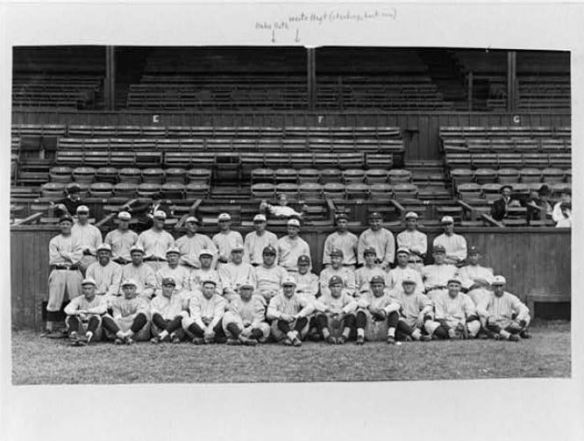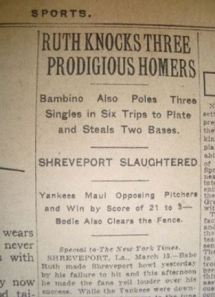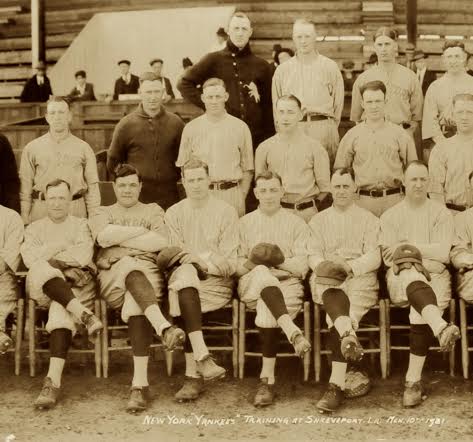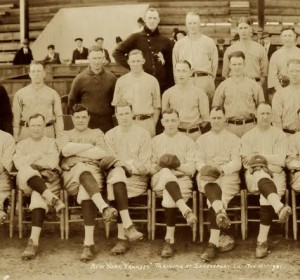Baseball fans, take a journey with me:
The year is 1921. It’s a mild day in March, and the professional baseball season is beginning to awaken from the offseason with the start of spring training. All over the South, pro baseball teams commence the shaking off of the rust of winter.
Being that you and I are die-hard baseball fans, we’ve been anticipating this for months.
We decide to head to the ballpark because we hear the local minor league team has an exciting matchup today. We don’t go to Fair Grounds Field, and we’re not rooting for the Captains; neither will be around for another 50-plus years. In 1921, we’re cheering on the Shreveport Gassers at Gasser Park. And today, they’re playing the New York Yankees. Yes, those New York Yankees.
Shreveport has been abuzz for weeks with the news that the Yankees and their star slugger, George Herman “Babe” Ruth, would be moving their spring training headquarters to our town. The best team of the era and the best player – arguably ever – will be walking the same streets we walk, eating at our restaurants, and showcasing their colossal talent before our very eyes. And as you and I head to the Gasser Park today, if we’re truly honest with ourselves regarding why, we’ll admit it’s not to root for the home team. We want to see the greatest team in baseball with the greatest player in the world.
We arrive at the stadium hours early to watch Babe Ruth take batting practice, and Gasser Park is already over capacity. Although we have reserved seats behind third base, it looks like – at least until after the batting practice crowd subsides – we’re stuck with the masses way back around the left field foul pole. Someone next us murmurs that he’s on the field, but we’re unable to confirm this with our own eyes for the sea of people blocking our view of home plate. Time goes by without a sure spotting of The Babe, and even though we hear the rumble of excitement coming from the grandstand, we start to wonder if he’s really at the ballpark today.
Then, without warning, a thunderous crack of a bat refocusses our attention towards home plate. We see an object rocketing away from the batter’s vicinity, appearing to still be climbing into the ethers as it clears the center field wall. We hear another loud crack at the plate, followed by the same outcome. And again. It happens nine times with the rush of the swings stealing the breath of each onlooker.
As the last ball soars over our heads and crashes through the window of a passing streetcar long past left field, we realize that a good portion of the crowd that had blocked the path to our seats had succumbed to the allure of catching a Babe Ruth home run ball and migrated toward the lawn and street behind center field. We make it to our seats just as batting practice ends.
The game won’t be starting for quite some time, so while the flood of onlookers dissipates from the grandstand, the team decides now would be a good time for a couple of photos. We watch from our seats alongside the 3rd-base line as the moment is captured.

Babe Ruth (center) and the New York Yankees at Shreveport’s Gasser Field. Source: http://baseballzen9.wordpress.com/
The game comes and goes in a blur of excitement, and we leave the ballpark a little dazed from the experience – almost numb. The home-team Gassers lose to the Yankees by a score of 21 to… Well, to be honest, we don’t care the slightest about the score. All of our attention has been on the Sultan of Swat and what he does better than anyone else on the planet. We’re leaving Gasser Park as victors, recalling him wallop three homers (including a grand slam), three singles, and – uncharacteristically – two stolen bases. Long before Sportscenter, a loop of highlights broadcasts in our thoughts as we make our way home. It is time spent in utter silence, quietly acknowledging that we were just in the presence of an ultra-human. Today we witnessed an icon at work before our very eyes.

From the New York Times, March 1921.
Ruth will go on to hit .378 with 59 homers in the 1921 MLB season, one of the most prolific seasons in baseball history. The Yankees will spend only one spring headquartering in Shreveport. Without television, we probably won’t see him play ever again. This has been our – and the rest of Shreveport’s – only glimpse at Babe Ruth.
In the years to come, Gasser Park will change names a few times, and then close altogether. A new minor-league team called the Captains will come to town, they’ll build stadium, and then will eventually meet the same fate as the Gassers. And so has all of pro baseball in Shreveport .
But, in 2014, if you go to the corner of Dove and Sycamore in Shreveport, you’ll find a field and a ghostly, dilapidated grandstand with a plaque that reads “Galilee Stewart-Belle Stadium”. If you’re lucky enough, you’ll walk out to the area where home plate was and realize he once walked here. You’ll look out to center field and see what he once saw. You will almost hear the roar of the crowd he heard going on 100 years back. You will feel the presence of Babe Ruth – and baseball – still lingering in Shreveport.



